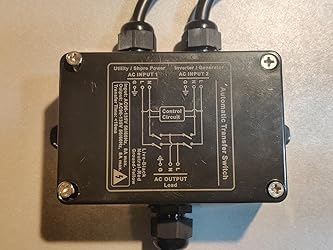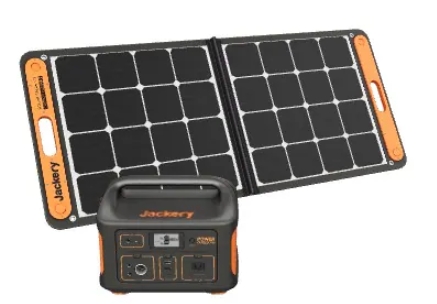Customer Reviews With Photos
Reading is way off. It's showing 369W from a 200W panel, which is impossible. I verified with another meter which showed correctly closer to the 200W panel rating. Don't know if I got a defective unit or this is QC issue. Returning this.

I tested basic functionality by switching back and forth from grid to inverter power - works quickly and without issue. Next, I took it apart to inspect - no major issues. The board is marked "Vin AC 270V-100V". I asked the seller about this and they reiterated that this module is 120V only. So I'm not sure what that's all about. Only other oddity is that the main fuse is an automotive "mini" fuse. Those are normally rated up to 32V DC, but AC circuits don't require as big a gap to properly break. Just to be sure, I tested the overload protection using a 1500W heat gun. I'm pleased to report the fuse blew quickly and without damage to any other part of the module. Sure, it would be great if this transfer switch could handle higher currents, but for what it is, it's a well-designed module and I'm happy to recommend it.

No me agrado para nada no lo recomiendo

As a recent convert to the world of electric vehicles (EVs), I quickly ran into a snag - not enough outlets! We added a second EV to our household, and suddenly that single charger wasn't enough. An electrician to install a new outlet was an option, but a pricey one. Enter the Kanayu 14-50P Y Splitter Adapter Cord. Double the Charge, Half the Outlet Hassle: This splitter has been a lifesaver! Now I can charge both our EVs at the same time using just one outlet. It's a much more affordable solution than hiring an electrician. Bulkier Than Expected, But Fits: The splitter is a bit bulkier than the standard charging cables that came with our vehicles. This took a little extra effort to manage when connecting them to the already-mounted chargers on the wall. But it wasn't a dealbreaker - the splitter still fits comfortably in the designated charging area in our garage. Flexibility Matters (Especially in Tight Spaces): The cable itself isn't the most flexible. This made it a bit of a challenge to maneuver the splitter and get the plugs securely connected into the existing chargers. Having a little more give in the cable would have been ideal. Safety First: Plug Devices In Before Connecting to Power: I recommend plugging each device into the splitter first, then plugging the splitter itself into the outlet. While it seems like a small thing, trust me - this is the way to go! The snug fit of the plugs combined with the stiffer cable made connecting everything while the splitter was plugged in a bit awkward. Overall: Despite a couple of minor challenges, the Kanayu Y Splitter is a great solution for charging multiple EVs from a single outlet. It's affordable, easy to use, and gets the job done. Just be prepared for a slightly bulkier device and consider plugging your chargers into the splitter before connecting it to the wall outlet. Here's who I would recommend this for: EV owners who need to charge multiple vehicles but only have one outlet. People traveling with an RV and an EV and need to have both connected. People who are looking for an affordable solution to expand their EV charging capabilities. Here's who I would not recommend this for: Folks who need a super-flexible cable for tight spaces.

I have bought and installed 16 of these 100W 12V Eco-Worthy panels from tugapower.net, to add to my original field of 4 100W 12Vpanels made by Ramsond (they were the cheaper panel a few years ago, Renogy & Eco-Worthy seems to have taken their market place recently) Each of these panels produced 5.5A+ and normally over 20V in full Florida sun, as measured on my multi-meter (I've uploaded photos with this review) I have my 20 panels wired in series, in groups of 4, running to my Outback Flexmax80 MPPT charger via two 10AWG runs, to my bank of Trojan Deep Cycle Batteries. These panels give me the expected VOC of 80+ (48V nominal) and at the sun's peak of the day I get the expected 27 amps of current. (MPPT charge controllers take the extra high voltage and converts it to charging current, if you're not familiar with the technology, check it out - super efficient) The only issue (really a non-issue for them) that I didn't catch is that the panel is slightly thinner than the Renogy or Ramsond, which made securing them to my rack just a little bit uneven next to the fatter older panels. Also, the corners on the panels look a little sloppily put together, a few are bowed/bulged out instead of having a neat seam, but this aesthetic doesn't appear to create a functional problem and certainly cannot be seen from the ground when roof mounted & producing energy - so it's not a big deal for me. The panels are, in my experience so far, worth the money ($140.00 currently) compared to other competitors in the market place. I've liked them enough from my first order to place a couple subsequent orders to get me where I am now at 2000watts (2.0 KW) As a quick ending note for any newbies - you have to realize that in the realm of solar a 100W label on a product rarely gets you a true 100W of power. Using an MPPT charge controller will help with squeezing out the potential wattage, but especially if using a standard charge controller you have to understand that wattage is figured based on Amps out x Voltage, and non mppt charge controllers use the batteries voltage to determine the charging voltage. For example a fully charged 12V battery will be average 12.8vdc so a charge controller will charge just slightly above that - say at 13.1V. So, figure 13.1V charging potential X 5.5amps (lets use 1 panel in full sun for simplicity) = 72watts of power from that panel. If using a MPPT charge controller, it takes the panels VOC, which in this case is about 20v x the same 5.5 amps = 110watts of power and is able to take all of the power from the panel it COULD produce and push more current into the battery than it otherwise would. So, conversely a discharged battery at say 11.8V (charging from a panel like this, in full sun) x 5.5amps = 64.9watts into the battery. Panels like these CAN produce their rated power in full sun and generally with the assistance of a mppt controller (because until your battery is darn near charged, you only get about 2/3 of your rated power production... and by then you don't need it as much because your battery is full!) I hope this helps anyone who may be mystified as to why their power production calculations aren't working out - usually it isn't the panel - it's the charging conditions including angle to the sun / time of year. Since going to MPPT, I've increased my solar harvest a lot... All after several years of head scratching. Happy harvesting folks! - David


